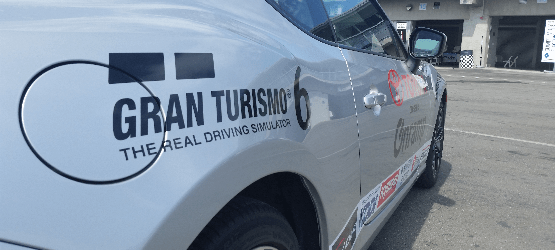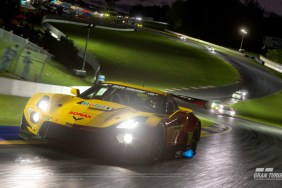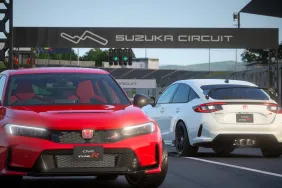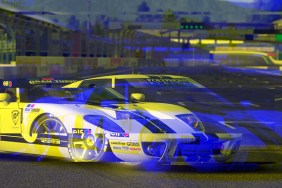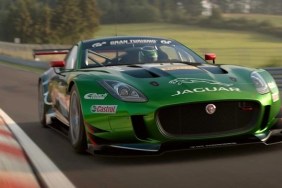Toyota wants folks to fall in love with cars again. Most people these days see their car, if they even own one, as a way to get from A to B. Seemingly gone are the days that people took great pride in their wheels and not only kept them bright and shiny, but enjoyed driving them every chance they got. Now with the coming of the Prius and hybrids galore, vehicles are simply tools that are used and then put away, with more emphasis on utility and less on performance and fun.
Now I’m not trying to sound like a car commercial, but Toyota has a valid point. As a kid growing up in the 80s, my car was everything to me. Owning a ’76 Rally Sport Camaro gave me a sense of pride as I cruised to and from high school and through town on the weekends. Rebuilding the engine with my own two hands and keeping the car running and looking great was just as important as my SATs. It didn’t take much technical know how back then, just the proper guidance and a basic skill-set. I know cars are more advanced these days as I had to further my own automotive education before I went to work for a car manufacturer at a dealership, but my point is I had a pride of ownership and a love of cars that seems to be lost. With high school and college age kids of my own, I see that folks don’t have that same car love or car pride I grew up around.
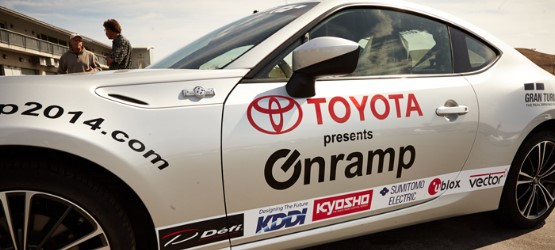
Toyota is hoping to change that by luring some of these folks back with technology that can be linked from their car to most smartphones and tablets, and can even create data that can be imported into Gran Turismo 6. With the advancement of technology already present in the Scion FR-S, this marrying of technology between smart phones and cars requires very little hardware from consumers. Toyota’s CAN-Gateway ECU comes built into the brain of the FR-S and, with a data logger installed, will allow a person to link their smart phone to their car using bluetooth to get real time data straight to their phone or a USB drive. If installed on a race car, you can see how real world drivers did on any given Gran Turismo 6 track.
This last week we were invited to the Toyota Onramp 2014 event at Laguna Seca just outside Monterrey, California. While there, I got behind the wheel of Toyota’s Scion FR-S 4-cylinder sports car and took it for a track session twice. With an instructor beside me helping me to understand the proper racing lines, I realized right away that Gran Turismo 6 truly is a real life racing simulator. In anticipation of actually driving on Laguna Seca, I spent the weekend honing my skills in-game upon that track and my racing line in real life mimicked what was in the game. To go from racing an FR-S in-game, and then actually driving one on the same track gave testament to what a real racing simulator GT6 is.
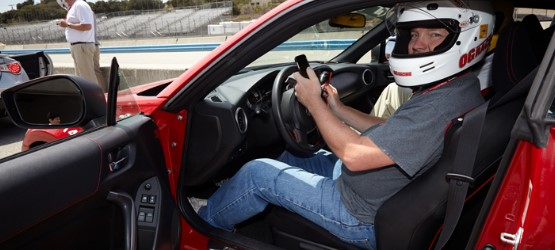
Originally I was only scheduled to drive for one session, but apparently you are supposed to press a button on the data logger in order to start recording data. No one had told me or my driving instructor so they made me race again in the afternoon session. It only took a little cajoling and a pretty please, but I gave in and did four more laps. Thanks to my practice time spent in GT 6, a peppy little car, and a few adjustments by my instructor, my lap times weren’t bad. My final lap was 2:19, and for a guy that had never driven on a professional race track, other than a dirt 1/4 mile oval, that’s not too shabby.
Once I had my recorded session on USB, I was able to import it into one of the PS3’s set-up in the pit and import my data into GT6. With a few minor adjustments to the X and Y axis in-game, I could watch my real laps on a virtual Laguna Seca, and even race my ghost if I wanted to. This technology is still new so there were a few hiccups, but the overall importation of data into GT6 worked well. They even let me take the USB stick home so I could import the data into my own PS3.
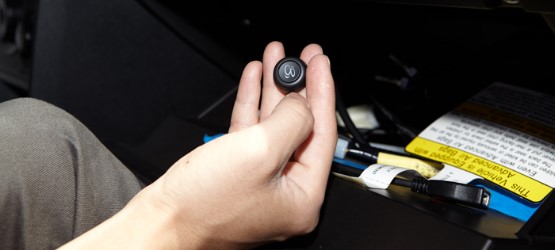
The real world implications of this technology could open the door to something no one has ever achieved before, and that would be to record the data of racers from a real race, and then let gamers take on those guys in a virtual world. When I say record data, I’m talking GPS as well as speed, RPM, fuel, etc. Want to try to beat Randy Probst’s record time of 1:33.62 at Laguna Seca, and see his exact ghost in front (or maybe behind) you? In theory this tech would allow that, though he would have to match that run again with the logger installed. Knowing him, and if he had access to that same SRT Viper TA again, he’d probably beat his own lap time and make the challenge even harder.
While I was one of the only invited attendees to actually drive one of these cars, there were a bunch of other folks that got to sit as a passenger in the car and take a couple laps around the track. Each of these riders also had their data imported into GT6 and were shown what their lap looked like in a virtual world. There to help keep the game running smooth and to help import the data into GT6 was the Product Manager for SCEA and Brand Manager for Gran Turismo, Ken Chan. I sat down with him for an informal chat about Polyphony and Toyota’s coming together, how GT6 was used to convert Akio Toyoda into a fan of the series, and more.
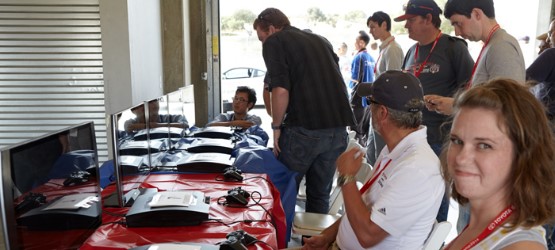
If you are a fan of GT6, then you know about Toyota’s FT1 concept car, and that you can download and drive it in GT6. What you may not know is that the car was built, from the ground up, with the idea of putting it into GT6 and then using that virtual car to convince not only Mr. Toyoda, but also the entire board of what Toyota could do if they really put their best and brightest on the task of creating a high end, luxury based super car.
Unknown to Mr. Toyoda at the time of creation, the FT-1 was introduced to him in GT6, with a complete racing rig for him to sit in and virtually drive the car at Fuji Speed Way. Some may not know this, but Mr. Toyoda has some real life driving skills and has driven a Lexus LF-A at Fuji himself with some decent lap times. Once he strapped into the racing rig and saw first hand the virtual model of the car, he fell in love with the design. He then took the car and drove it at Fuji Speedway in-game. The fact that the car made an appearance at the Detroit Auto Show should tell you his overall reaction. He was not only sold on the concept car, but the idea of using GT6 as a tool to help further the cause of bringing car lovers back to the fold.
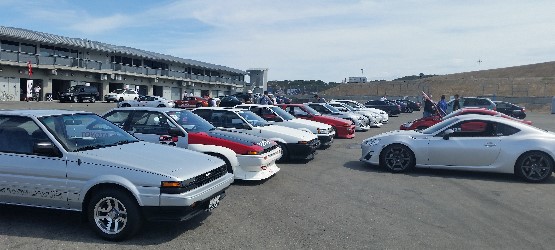
During my conversation with Ken I found that he is also a car lover and tuner. He has worked on the Gran Turismo series for many years and has also kept up his car hobby even longer. He reiterated the point of trying to bring car lovers back to the fold using new technology married to smart phones and tablets. Ken’s work with GT Academy is a shining example of his dedication to the series and to the real world of cars. It is also another great example of how GT6 is a true racing simulator.
Toyota will continue their drive to bring car lovers back to the car loving fold during the September Onramp event, to be held the weekend of September 27-28, 2014 at the Alameda Naval Base here in Northern California. It will feature a 24-hour codefest starting Saturday morning. Apps will be created around the themes of fun, efficiency and safety, using the new and experimental CAN Gateway-ECU technology that can send data real-time over Bluetooth to iOS and Android devices. This technology will be demonstrated live by professional drivers in FR-S sports cars on courses at the former naval base. A panel of judges will review the entries and Onramp will award prizes for the top apps. That Sunday will offer additional opportunities for the tech and car communities to network. There will also be several GT6 racing rigs set up for attendees to try and match the on-track performances of the professional drivers.

I look forward to attending the upcoming event and can’t wait to see some of the great mobile apps created by the tech companies involved in the codefest. Cars have come a long ways since I owned my first car, and I truly hope that a new generation of car lovers will be joining me in my appreciation and pride of ownership that comes from knowing that a car is more than just a tool, but can be an expression of our own selves and can help project pride and confidence.
Big thanks to Ken Chan for taking the time to talk to me and shed a little light on Toyota and Polyphony’s coming together as well as his own personal opinions on the car scene. Huge thanks and a shout out to Krista Van Lewen from ComStrat PR for reaching out and inviting us to get behind the wheel and out on the track.
